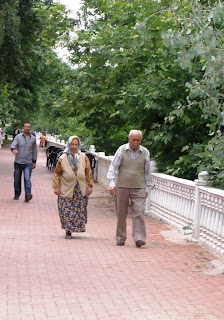 |
| River and bridge at Silifke |
 |
| Old man on curb. Played terribly! Tone deaf. |
There are several tourist sights located at Silifke and we had hoped to see a few places. There is a Byzantine hilltop fortress with 2 dozen towers and vaulted underground chambers in which tourists are free to clamor about and explore. It also has a moat that is still identifiable. There also is a necropolis which contains a few remains of an ancient Roman Temple of Jupiter from second century A.D. It was turned into a Christian basilica sometime in the fifth century, but today only a few columns remain visible of this old temple.
 |
| Table for tea set in alleyway in Silifke |
The thing that we most wanted to see is the Tekir Ambari, which is an ancient cistern carved from rock. You can enter inside the cistern via a spiral staircase. This intrigued us because both Bill and I have read 'The Source' by James Michener. This book centers around a well that over many centuries becomes covered with layer upon layer of soil. Eventually the well is located way below the ground surface and is accessible only via a steep winding staircase. 'The Source' is a wonderful book that explains how the land now known as Israel is really the source of the concept of a singular entity as God rather than many gods. This land is the where Judaism, Islam and Christianity were formed. Like it or not, all 3 religions have equal claim to that land when viewed from either historical or religious aspects.
 |
| Kitchen; very clean and organized |
 |
| Turkish kosak pants |
 |
| Working in kosak pants |
 |
| Typical dress |
 |
| Couple strolling on river walkway |
 |
| Teenage girls are the same everywhere |
On our second day dealing with Turkcell in Silifke a young man spoke to us in English. His name was Cenl (pronounced chanel) and he had learned English at the tourism school. He offered to help us communicate in the main Turkcell store. He was a great help. Trying to communicate using Google translate leaves lot to be desired. Those translations are never verbatim and sometimes downright funny. Cenl got our questions answered quickly and accurately.
After we settled the Turkcell issues, we walked with Cenl to the old Ottoman home where his friend has established a restaurant. It was lovely! They have filled this large very old home with all sorts of Ottoman antiques. There are dining rooms scattered about the home on every level, and a few private rooms. And lovely courtyard dining and a small outdoor bar.
 |
| Ancient scales |
 |
| Turkish water smoking pipe |
 |
| Customer sampling a Turkish smoking water pipe |
We ate lunch at the restaurant and shared tea with Cenl and his partner/restaurant owner. Finding this restaurant was a nice surprise and we feel lucky to have chanced acquaintance with Cenl and that he was kind enough to lend his English/Turkish communication assistance.
 |
| Old Ottoman gun hung over window |
After lunch we walked back to the original small Turkcell store and purchased a locked Turkcell 3G modem. To stay at the Tasucu dock for another 3 nights while our original 3G modem would have the passport block removed and be re-registered with the new simm card would cost 75 TL. We purchased the new locked 3G modem for 60 TL. And we can deal with unblocking and re-registering the original 3G somewhere else later (hopefully where someone speaks English). Sunday morning Bill got the new block 3G working correctly and we departed Tasucu.
 |
| Less old Ottoman gun |
On the way out we passed a castle built by Armenian kings in the 12th century. It survived as a crusader castle until the 16th century, when the Ottomans captured it. This castle was situated top a small hill on the bay where we had anchored for the first night after our arrival from Cyprus. We had arrived too late in the day to feel comfortable entering the harbor at Tasucu and anchored at Aga Limani instead, behind Bagsakada (Provencal island). Provencal Isle was given to the Provencal Order of the Knights of St. John in the 13th century.
 |
| Castle near Aga Limani |
 |
| Castle near Aga Limani |
 |
| Ruins of ancient houses at Soguksu Limani |
 |
| Hundreds of hothouses at Soguksu, many more on opposite side of hill. |
Our next stop was the harbor of Bozyazi Limani at 36.05.752N 032.56.299E. It is very calm in this harbor although that is really the only positive I can say about it. This is not an attractive place. We stopped here hoping to visit the very large Mamure Castle and the ruins of ancient Anemurium. Bill is not feeling well and any sightseeing is delayed until he is back to normal. At first we thought he was just seasick from rolling so much in the last anchorage. But the dizziness persisted even after the boat was docked, so now we assume he has caught some sort of bug. He is much better today but not well enough to walk castle steps and ancient city ruins. Here we sit until he feels better.

No comments:
Post a Comment
Your comment will be posted after we confirm that you are not a cyber stalker.